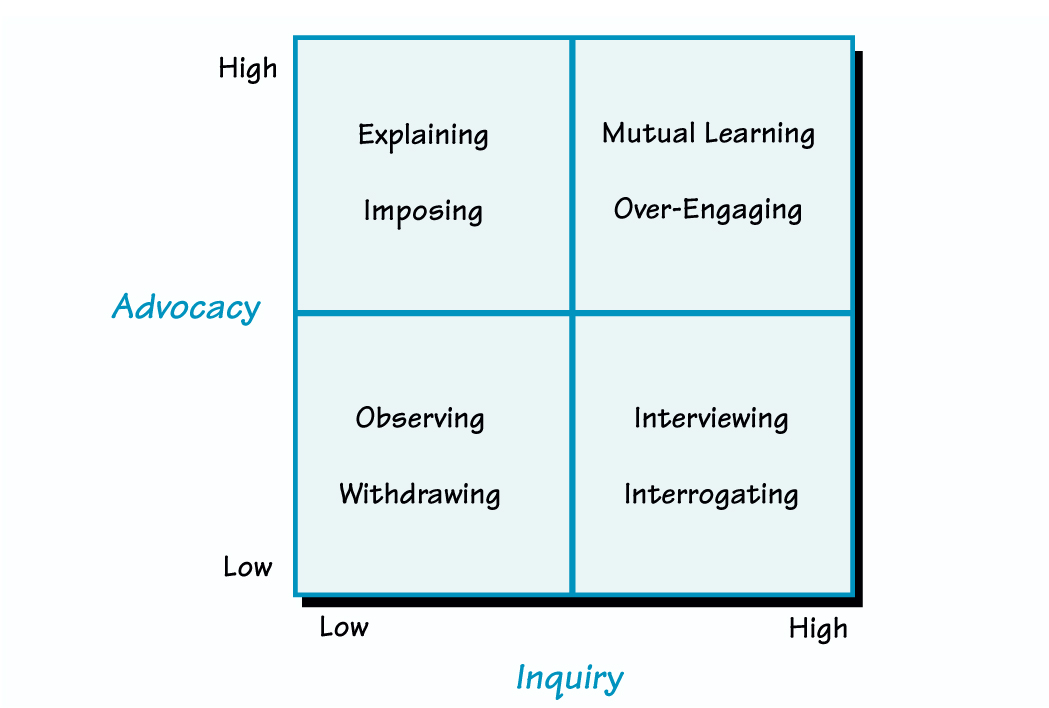We can gain leverage for improving conversations by paying attention to advocacy and inquiry. Advocacy is stating one’s views. Describing what I think, disclosing how I feel, expressing a judgment, urging a course of action, and giving an order are all forms of advocacy. Inquiry is asking a question. With genuine questions, the speaker seeks information. Rhetorical or leading questions are a kind of advocacy in disguise.
In any conversation we can be high or low on advocacy and we can be high or low on inquiry. This gives us a two-by-two diagram:

High/Low Advocacy and Inquiry
- High advocacy/low inquiry is one-way communication—even if both people are doing it! It can be useful for giving information, but doesn’t enhance understanding of diverse perspectives or build commitment to a course of action. Advocacy that imposes the speaker’s views on others usually creates compliance or resistance.
- High inquiry/low advocacy is one-way in a different sense: The speaker does not state his or her views. It can be useful for finding out information, but can create difficulty when the speaker has a hidden agenda and/or is using questions to get the other person to “discover” what the speaker already thinks is right.
- Low inquiry/low advocacy also flows in one direction: People watch but contribute little. This approach works when being an observer is useful, but it can create difficulty when people withhold their views on key issues.
- High advocacy/high inquiry fosters two-way communication and learning. I state my views and I inquire into yours; I invite you to state your views and inquire into mine.
Moving up the Learning Curve
Balancing advocacy with inquiry is necessary—but insufficient— for ensuring learning. For mutual learning to occur, the quality of advocacy and inquiry is also critical. Saying, “That’s a stupid idea. Were you born that way?” is both a statement and a question, but it doesn’t promote learning. The Ladder of Inference is one tool that can help guide high-quality advocacy and inquiry.
- High-quality advocacy involves providing data and explaining how you move from these data to your view of the situation.
- High-quality inquiry involves seeking others’ views, probing how they arrived at them, and encouraging them to challenge your perspective
- Balancing high-quality advocacy with high-quality inquiry makes significant learning possible for all players.
GENERAL GUIDELINES FOR PRODUCTIVE CONVERSATIONS
Frame of Mind
- If you assume that you are obviously right and that your job is to get others to realize what you already know, you will be unable to create mutual learning. Therefore:
- Assume you may be missing things others see, and seeing things others miss. If you start with this assumption, you will listen more intelligently and inquire more genuinely without downplaying your own views.
- Assume others are acting in ways that make sense to them and that they are seeking to act with integrity.
- Seek to understand what leads to behavior you find problematic. Are people caught in dilemmas? Are you contributing to the problem?
Advocacy
- Help others see what you see and how you think about it by giving examples of the data you select, stating the meaning that you find in the examples, and explaining the steps in your thinking.
- Describe your understanding of the other person’s reasoning.
- If you see negative consequences to what others are doing, identify the consequences without attributing intent to create those consequences. Distinguish between intent and impact.
- When you choose to disclose your emotions, do so without implying that the other person is primarily responsible for creating your emotional reactions.
Inquiry
- Find out how others see the situation by asking them to give examples of the data they select and to explain the steps in their thinking.
- Ask for help in finding out what you may be missing by encouraging others to identify possible gaps or errors in your thinking.
- When you have difficulty with how others are acting, ask them to explain what leads them to act as they do, in a tone that suggests they may have a reasonable answer.
- Inquire into others’ emotions.
- Ask for help in exploring whether you are unknowingly contributing to the problem.
